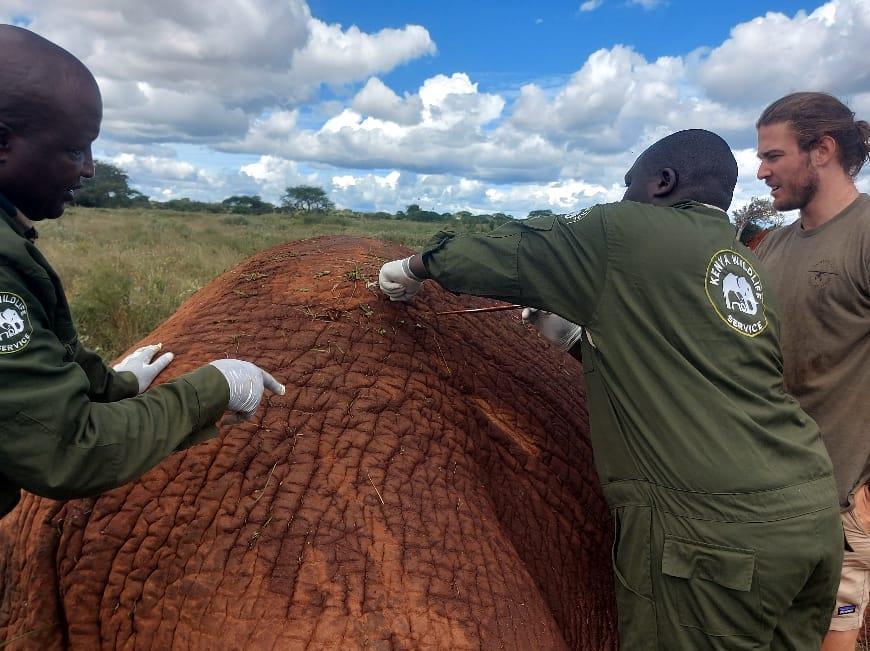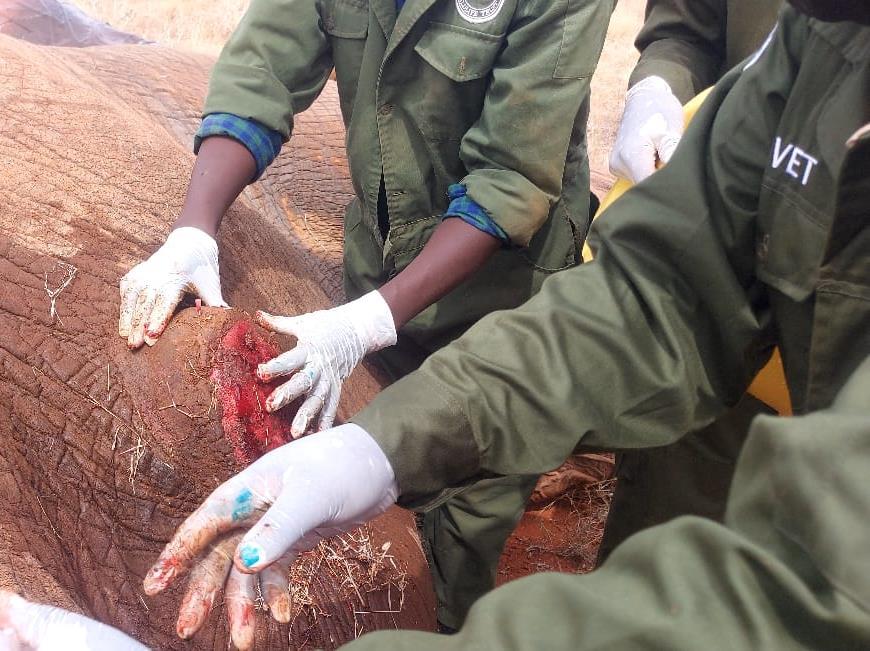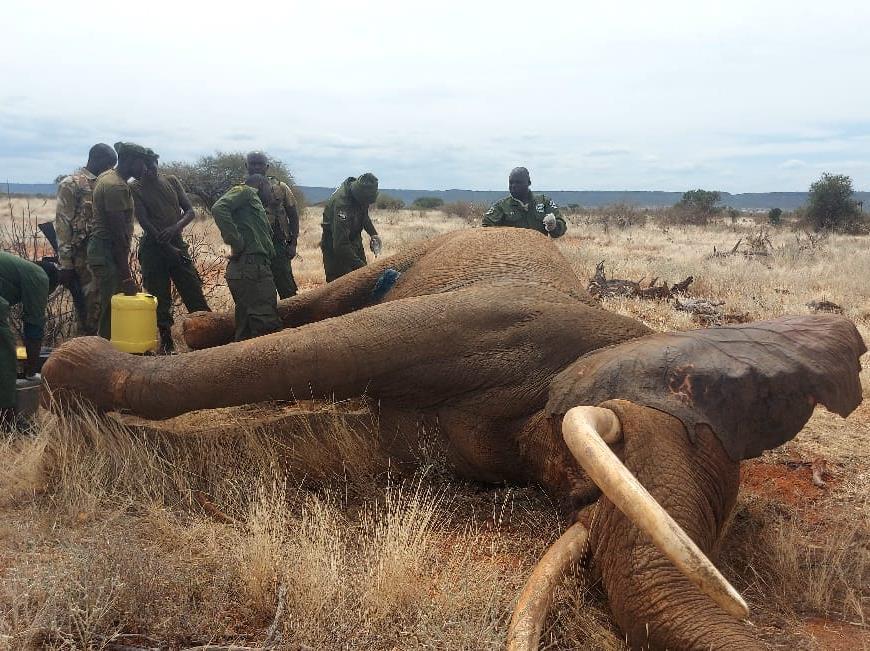




7 Cases in May 2 Poaching Cases
May Report by Dr. Campaign Limo

The Tsavo Conservation Area received relatively lower precipitation in May in comparison to the previous month. However, most water pans were still full by the end of the month and both grazers and browsers had enough food. The SWT/KWS Tsavo Mobile Veterinary Unit attended to 7 cases all of which involved elephants. 2 of these cases were poaching related, the 1st involved repeat treatment of an adult elephant bull with an arrow wound on the left shoulder while the other involved a female elephant calf with a deeply embedded winch wire snare on the left hind limb. Sadly, the calf died a few minutes post-treatment. The team also translocated an elephant cow and her 2 calves from a community area to Tsavo East National Park and treated an orphan female elephant named Juni at the Voi Stockades for a sprain/ strain on her right hind limb. Thankfully, Juni has since fully recovered. Additionally, the team attended to 3 adult elephants in separate cases with injuries attributed to natural causes. Unfortunately, one of these elephants was severely injured in a fight and given her poor prognosis was put to rest to alleviate further pain and suffering.
Acknowledgement
The Tsavo Mobile Veterinary Unit appreciates all the stakeholders who supported this month’s interventions including the monitoring and reporting of veterinary cases. The team thanks Kenya Wildlife Service management for providing technical support and The Sheldrick Wildlife Trust for funding the Tsavo Mobile Veterinary Unit.
Case Details
May 2024


Human – Wildlife Conflict
Mtito Andei Area
Residents of Mtito Andei area reported that 3 elephants (a mother and her 2 calves – male & female) had strayed from the park and were roaming in the community area which was raising alarm. KWS management requested the SWT/KWS Tsavo Mobile Veterinary Unit to translocate them to Tsavo East National Park.
Immobilization and translocation
The cow and the 2 calves were darted from a helicopter and immobilized with 17mg, 8mg, and 3mg Etorphine respectively. It took 8 minutes, 9 minutes, and 7 minutes for the drug to achieve its full effect on the mother and her calves.
The elephants were doused liberally with water to help cool them off. They were then loaded onto the translocation truck and tractor by a crane and transported to the release site in Tsavo East National Park. Anaesthesia monitoring was done during transit to ensure sufficient depth.
At the release site, the cow and the 2 young calves were simultaneously reversed using 200mg, 150mg and 100mg Naltrexone hydrochloride given intravenously via a prominent ear vein after 45 minutes in transit. 3 minutes later they all stood and walked away together into the nearby thicket.




Elephant
Natural Causes
Ziwani Area, Tsavo West National Park
This injured adult elephant bull was seen around Ziwani area by a SWT pilot on routine patrol. The elephant had a swelling on the lateral surface of his left thigh and wounds on the left and right flank.
Immobilisation, examination and treatment
The elephant bull was successfully darted from a helicopter and anaesthetized with 22mg Etorphine hydrochloride. Induction time was 7 minutes.
Examination revealed a swelling on the lateral surface of the left thigh and two other septic wounds on the left and right flank area. All the wounds were cleaned with water and all devitalized tissues, pus, and debris removed. The wounds were thereafter flushed with Hydrogen peroxide, rinsed with water and infused with tincture of Iodine. Antibiotic cream was applied on the wounds followed by topical application of antibiotic spray. Amoxicillin antibiotics and anti-inflammatories were also administered parenterally before anaesthesia was reversed with 250 mg Naltrexone hydrochloride given intravenously via a prominent ear vein.
Prognosis
The elephant has a good prognosis.




Natural Causes
Voi Stockades
At the Voi Stockades, a sub-adult female elephant named Juni was seen limping and favouring her right hind limb.


Immobilisation, examination and treatment
Juni was approached on foot and darted with 4mg Etorphine. It took 7 minutes for the drug to take full effect.
Examination revealed intact joints; there were no visible signs of inflammation on the limb and foot pad. It was determined that the pain she was experiencing could have been caused by a sprain or strain. Flunixin meglumine anti- inflammatory medication was administered parenterally and a few days rest was recommended to hasten recovery. Anaesthesia was reversed with 80mg Naltrexone hydrochloride given intravenously via a prominent ear vein. She stood 2 minutes later and walked into the stockade.
Prognosis
Juni has a good prognosis, and she has since fully recovered.


Elephant Arrow
Kasala Gate Area, Tsavo East National Park
An injured adult elephant bull with a swelling on the left shoulder was seen around Ithumba by a SWT/KWS De-snaring Unit. The bull had been treated for an arrow wound at an earlier date. The Tsavo Mobile Veterinary Unit was airlifted to the Kasala Gate area to attend to the elephant’s injuries.
Immobilisation, examination and treatment
The bull was darted from a helicopter and successfully immobilized with 18mg Etorphine hydrochloride. Full anaesthesia was achieved after 8 minutes.
Examination of the left shoulder area revealed a firm swelling with a small opening that was oozing pus. The wound was cleaned of debris and the opening extended to evacuate pus and devitalized tissue. There were bone fragments deep into the wound that had formed as a sequela of osteomyelitis on the fragment of scapular bone. These fragments were removed, then the wound was flushed with Hydrogen peroxide, rinsed with water, infused with tincture of Iodine, packed with antibiotic pessaries, and a topical antibiotic spray applied. Amoxicillin antibiotics and NSAID anti-inflammatory medication was also administered parenterally. Anaesthesia was reversed with 200 mg Naltrexone hydrochloride given intravenously via a prominent ear vein. The elephant bull stood and slowly walked away 3 minutes later.
Prognosis
The elephant bull has a good prognosis











